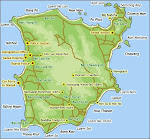- Sawadee khrap. Hello. Also good evening, goodbye, and even good-night
- Kop Khun kha. Thank you
- Mai Pen Rai khrap. It doesn't matter; It's OK, I'm cool about it, no problemo etc.
- Mai auw kha. A polite refusal - I don't need/want
- Arroy. Delicious!
- Mai Phet khrap. Not spicy. But don't be in too much of a rush to make this request. Thai restaurants that cater to tourists tone down their dishes, anyway.
There is no single, widely accepted formula for transliterating Thai into a Roman alphabet. Nor is one likely to appear soon.
Part of the problem is that English and Thai sounds aren’t really comparable. Take just one sound as an example: P. Hold a finger in front of your mouth and say 'Spain'. Now say 'pain'. You’ll probably notice more air coming out the second time. We use the same letter 'p' to represent both the more - and the less-aspirated sounds; the Thais distinguish between them. This is why the island in southern Thailand is variously spelled Phuket and Puket. The 'ph' (pronounced as an aspirated 'p', not as the 'f' sound of 'photograph') is sometimes used to represent this sound.
The unaspirated P, on the other hand, sounds almost like our letter B, and can be found transliterated as either B or P. Likewise, there’s a sound that can be represented by K or G; another that is between a T and D.
Consequently, items like street maps and road signs can be quite confusing for a Westerner visiting Thailand. If you’ve got two maps on which names have been transliterated into English, they may use different spellings. The same happens with proper names. The King's name is variously spelled Bhumibol and Phumiphon
Wait ... It gets worse. When you speak Thai, a single syllable can be spoken with any of five vocal pitches. Low, medium, high, rising, or falling pitches each have different meanings. The sentence mai mai mai mai, mai, often quoted in language books, means new wood doesn’t burn, does it? Each mai is spoken with a different intonation.
Since tone changes meaning, Thai speakers don’t raise their voice at the end of a question, as English speakers do. When necessary, a question word such as where, how much, or why, is inserted at the appropriate point in the sentence.
And one other thing: Thai offers ten ways to say 'you', depending on whether you’re speaking to a friend, a family member, someone higher or lower than you by age or standing on the social hierarchy, and so on.
So, is there any good news for someone wishing to learn Thai? Yes. The grammar is a lot simpler than for most European languages. Thai has none of that hard-to-remember masculine-feminine stuff for inanimate objects, no past or future tenses of verbs, not even plurals. The tonality is the trickiest part, and if you've got an aptitude for music, you'll have a better chance than most of mastering this language. Chok dee! Good luck!














No comments:
Post a Comment